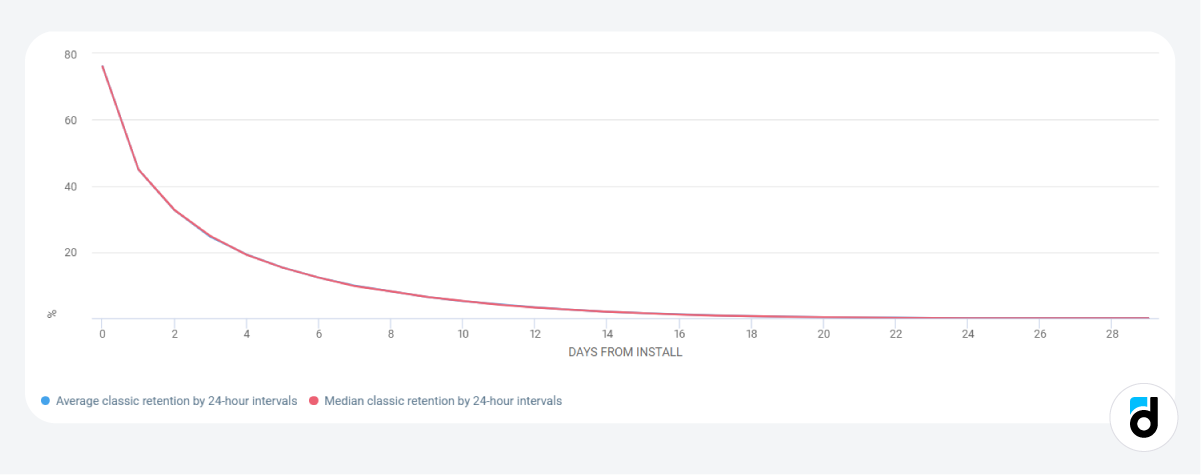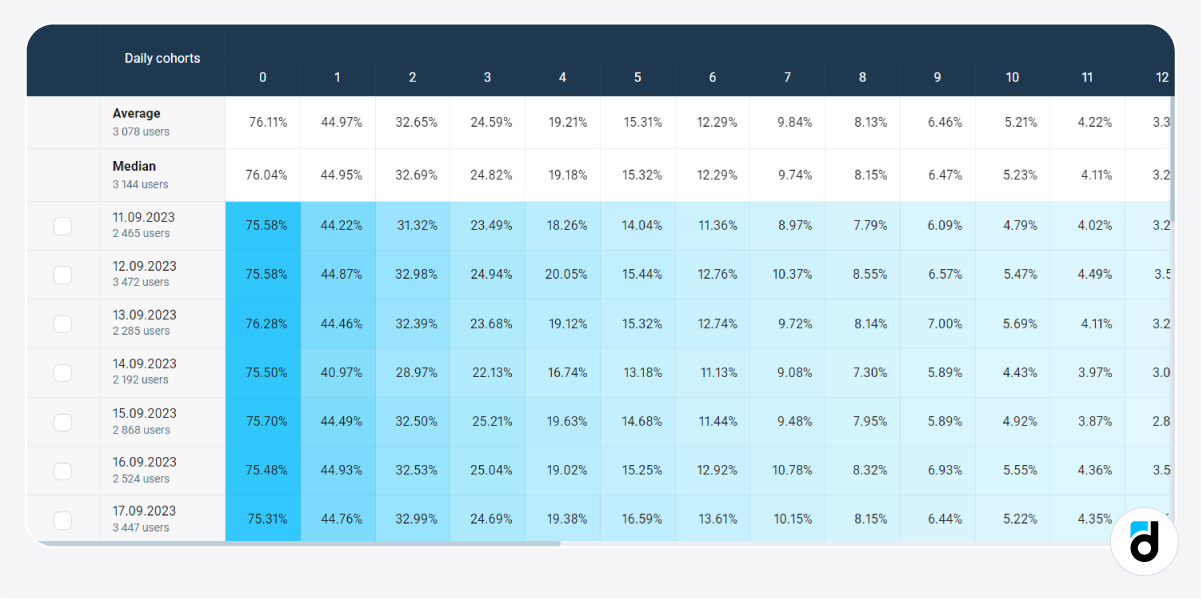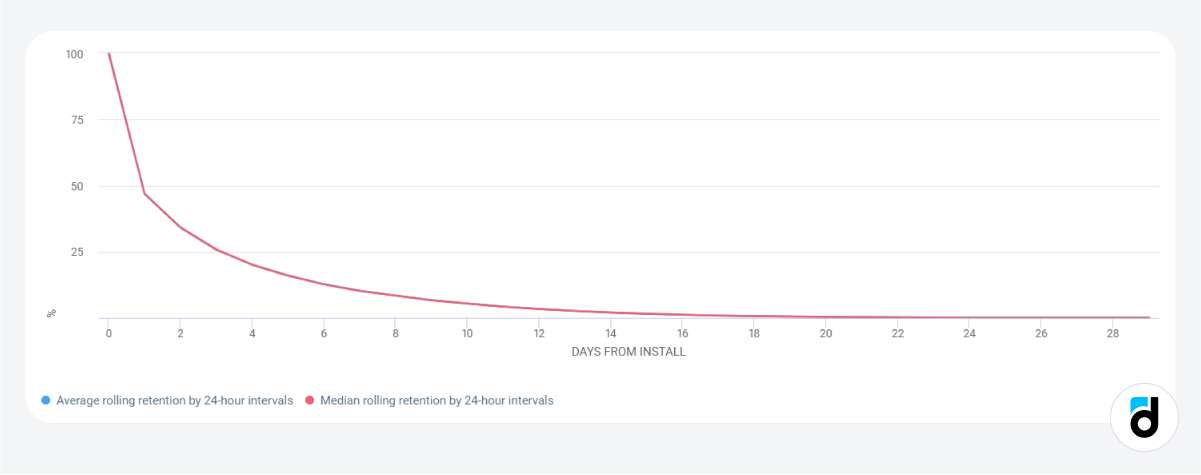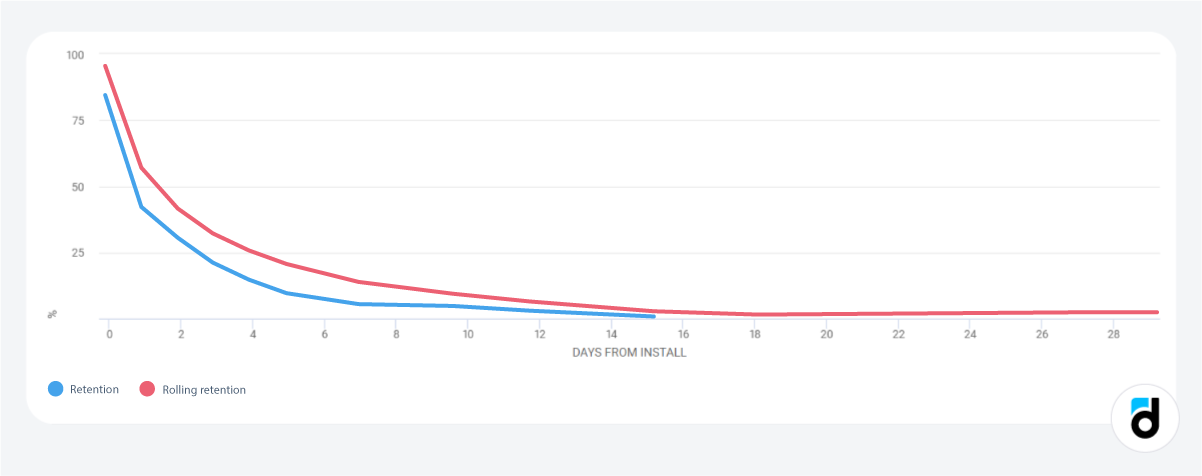If you aim to maximize profits for your project, it's essential to attract as many users as possible. These users will pay for access or make purchases within the in-game store. Simultaneously, you should strive to keep the audience interested in returning to the product frequently and for extended periods.
Retention is a pivotal metric in the analysis of games and applications, as it directly influences your revenue.
In this article, we will distinguish between two key types of retention: classic user retention and rolling retention.
Read more: Retention is Dropping - What to Do?
Classic Retention
Classic user retention refers to a product or service's capacity to maintain user engagement and activity over a specified timeframe. It quantifies the number of users who initially interact with an application and continue to use it in the subsequent days, weeks, or months.
The ideal scenario occurs when users consistently rely on your app, turning to it whenever they encounter specific issues. However, retention rates differ across various projects depending on their genre. For instance, many of us visit social networks multiple times a day, while we book hotels far less frequently. Consequently, the retention rates for these applications will vary significantly.
The formula for calculating retention is straightforward:
Day N Retention Rate = (Number of users who opened the application on day N / Number of users who installed the application N days ago) * 100%

By utilizing the retention value, you can determine the percentage of users within a specific cohort (those who installed the application N days ago) who opened the application on day N.
Read more: Retention is Dropping - What to Do?
As mentioned earlier, for ease of comparison, user retention is typically assessed on a daily, weekly, or monthly basis.
D1 retention reflects the user's initial experience, including their first impression of how well the app addresses their needs, tasks, and requests. Paying close attention to D1 retention rate is crucial because it enables you to make forecasts for the future. If D1 retention falls below the anticipated value during a soft launch, it signifies that users might have difficulty grasping the product's essence, advantages, and its value to them, in other words, their "activation."
D7 retention reflects the percentage of users who find the project satisfactory but have not yet developed loyalty to it.
D28 retention is the percentage of users who have fully grasped the app's or game's functionality and use it regularly. It's likely that they have become accustomed to it and have no immediate plans to switch to an alternative. These are the users most likely to make payments within your product.

Let’s use the formula above and practice retention rate calculation.
For example, if an app had 1,000 users at the beginning of a month and 800 of them are active at the first day of that month, the D1 retention rate would be:
(800 / 1,000) x 100 = 80%.
If the same app had 600 active users at the seventh day of that month, the D7 user retention rate would be:
(600 / 1,000) x 100 = 60%.
And so on. You can see the pattern here.
Retention calculation is not as easy as it seems. Read more about the methods.
Rolling Retention
Rolling retention is a more nuanced and dynamic metric that focuses on the continuous engagement of users. Unlike classic user retention, which measures users over fixed time periods, rolling retention calculates the percentage of users who continue to use the app from a specific point in time, regardless of when they first started using it.
The formula for calculating rolling retention is as follows:
Day N rolling retention = (Number of users who opened the application on day N or later / Number of users who installed the application N days ago) * 100%

In simpler terms, this metric represents the percentage of users who came back to the application on day N or later, starting from the day of installation.
For instance, if one user returned on the 14th day and the 45th day, and another user returned on the 44th day, when calculating the day 14 rolling retention, both users would be counted as having returned on the 14th day.
Rolling retention consistently yields higher values than the classic retention metric because it considers not only those users who opened the application on a specific day but also includes users who returned at later times. Consequently, the rolling retention graph exhibits a smoother trend:

The primary challenge associated with rolling retention lies in its practical implementation. Unlike the classic retention metric, rolling retention requires daily recalculations. This is because users who have not accessed the application for a while and were initially considered as churned may re-engage with it. Consequently, rolling retention values for all previous days are subject to change.
To illustrate, suppose a user's last application usage occurred on the tenth day after installation. We calculate the day 25 rolling retention without factoring in this user. However, on day 30, that user reopens the application. To include them, we must recalculate rolling retention for all days from the 11th to the 30th.
Rolling retention provides developers with a more detailed perspective on user engagement trends. This can be invaluable for showing user drop-off points or understanding the impact of specific features or updates on user behavior. For instance, when we measure the traditional day 7 retention, we automatically assume that anyone not opening the application on that day has churned. Yet, they might not have abandoned the application entirely and could return, say, the next day.
Read more: How to Identify and Re-Engage Churned Users
At Devtodev analytics platform, we believe this metric is especially valuable for applications that are not intended for daily use. For example, it proves beneficial for taxi, delivery or sports apps.
Differences Between Classic Retention and Rolling Retention
Now that we've explored both classic retention and rolling retention, let's highlight their key differences:
Time periods
-
Classic retention measures the percentage of users who continue to use a product or service over a fixed time period. It typically focuses on a specific time frame, such as a week or a month. Classic retention is a snapshot of user retention at a particular point in time.
-
Rolling retention, on the other hand, measures user retention over a continuous and rolling time period. It does not focus on fixed intervals but instead tracks user engagement from the moment they first use the product. It provides a more dynamic and ongoing view of retention.
Flexibility
-
Classic retention is fixed to a specific time window. For example, if you're calculating monthly classic retention for January, you would only consider user activity within that single month.
-
Rolling retention does not have a fixed time window. It continuously calculates retention from the moment users start using the product, regardless of when that occurs. This means you can track user retention over any time frame, making it more flexible for analysis.
Details
-
Classic retention is typically reported for specific time periods, such as daily, weekly, or monthly. It provides insights into how many users from a cohort are still active after a fixed interval.
-
Rolling retention can be measured at various levels: from daily to weekly, monthly, or any custom timeframe. It provides a more detailed picture of how users are retained over time, without being limited to fixed reporting intervals.
Conclusion
Classic user retention and rolling retention are both vital metrics for understanding and improving user engagement in your app or game. While classic retention provides insights over fixed time periods, rolling retention offers a more dynamic and flexible perspective on user engagement. By using these metrics in conjunction, developers can gain a comprehensive understanding of their user base and make data-driven decisions to enhance their products, ultimately leading to sustainable growth and success.

